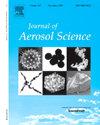Optimization of nozzle geometry for virtual impaction across more than one decade in particle size
IF 3.9
3区 环境科学与生态学
Q2 ENGINEERING, CHEMICAL
引用次数: 0
Abstract
Virtual Impactors (VIs) are devices used to inertially concentrate particles from a larger set of sample flow streamlines to a smaller fraction of minor flow streamlines. Ideally, a VI would function for particles across a wide size range, from submicrometer to supermicrometer diameters. However, pushing VI operation to concentrate submicrometer particles typically leads to inlet losses, as well as overfocusing and internal losses, for supermicrometer particles. Here, we utilized a combination of particle trajectory calculations and experiments to design a round-nozzle VI capable of concentrating submicrometer particles while maintaining performance for particles approaching 10 in diameter. First, we simulated particle trajectories in more than 140 test nozzle geometries, varying inlet length, diameter, angle, and concavity. Simulating atmospheric pressure upstream, and nozzle Mach numbers exceeding 0.3 (compressible flow), nozzles were then ”Scored” based on their ability to inertially focus particles in the 100 nm to 10 diameter range to the inner 10% of their area, at the nozzle outlet. Subsequently, we used two high-scoring nozzle geometries to design and contruct single nozzle VIs, which were experimentally tested with monodisperse particles in the 100 nm - 10 diameter range. Based on these measurements, a nozzle geometry capable of functioning for particles down below 500 nm while maintaining the ability to concentrate particles above 5 was then utilized in designing a single-stage, 16-nozzle VI. Operating with a sample flow of 40 and a minor flow of 1.2 , the multinozzle VI enables concentration increases by a factor in excess of 25 across more than a decade in particle diameter.
求助全文
约1分钟内获得全文
求助全文
来源期刊

Journal of Aerosol Science
环境科学-工程:化工
CiteScore
8.80
自引率
8.90%
发文量
127
审稿时长
35 days
期刊介绍:
Founded in 1970, the Journal of Aerosol Science considers itself the prime vehicle for the publication of original work as well as reviews related to fundamental and applied aerosol research, as well as aerosol instrumentation. Its content is directed at scientists working in engineering disciplines, as well as physics, chemistry, and environmental sciences.
The editors welcome submissions of papers describing recent experimental, numerical, and theoretical research related to the following topics:
1. Fundamental Aerosol Science.
2. Applied Aerosol Science.
3. Instrumentation & Measurement Methods.
 求助内容:
求助内容: 应助结果提醒方式:
应助结果提醒方式:


